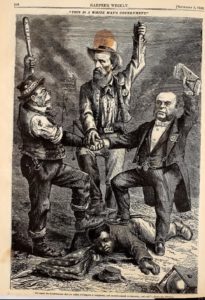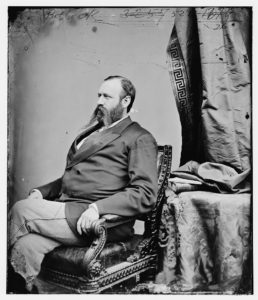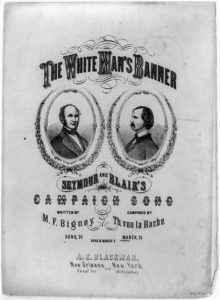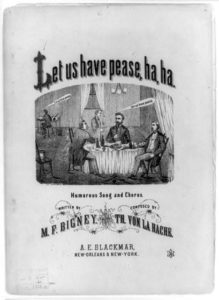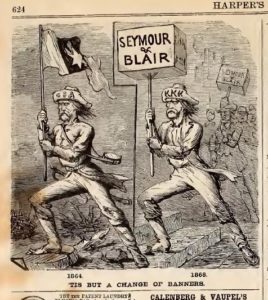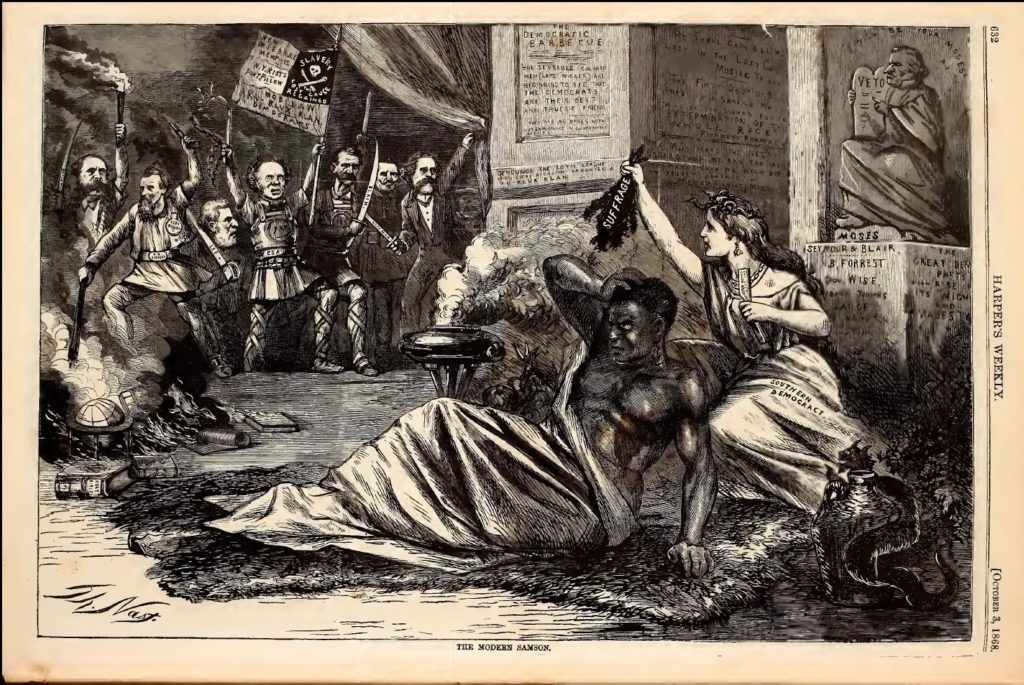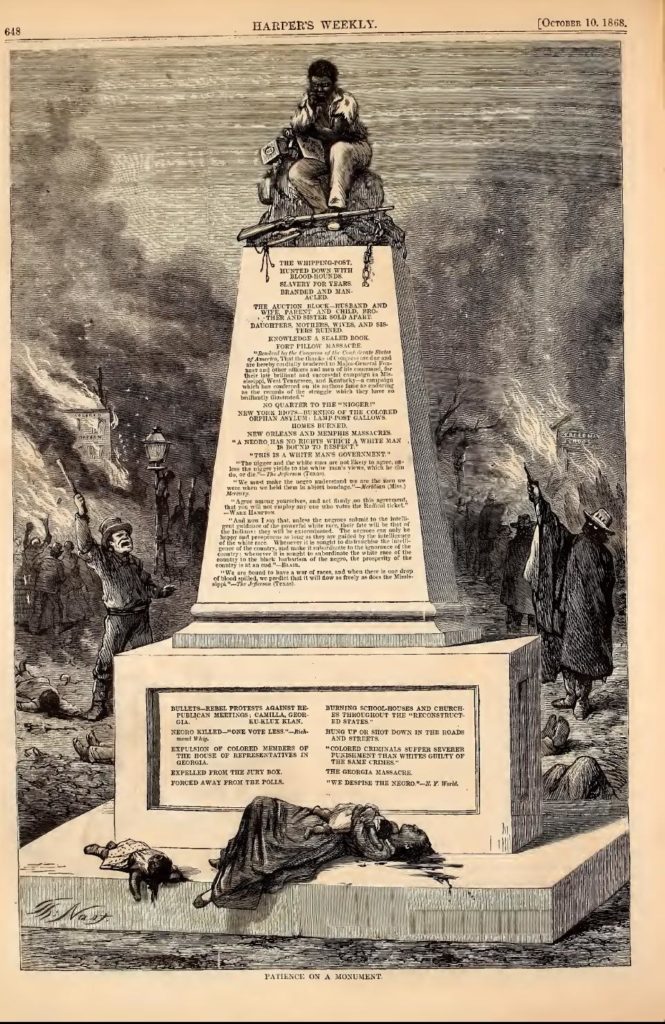In its September 22, 1868 issue the The New-York Times published a report of political violence in southeastern Georgia that occurred on September 19th. A couple of Republican politicians traveled to Camilla for a rally. As they neared the town an armed “rebel” warned them to stay away. They didn’t turn back, even after the Sheriff later told them “the people would not allow a Radical to speak in Camilla. They persisted, however, and on reaching the Courthouse, they and their friends were assaulted by a mob.” The two politicians were wounded, and many more Republicans, most of whom were black, were killed or wounded. Most of the blacks were unarmed and “were of course beaten and shot down by the Seymour Democracy, almost without any resistance.”
As more information made its way north, the October 10, 1868 issue of Harper’s Weekly didn’t claim to know all the facts but said that the “fair presumption” was against the former rebels:
THE CAMILLA RIOT.
It is not easy to ascertain accurately the facts in any case of violence in the late rebel States. Usually, however, when it is a conflict between rebels and the Union men of any color, the fair presumption is against the former. The Union men, knowing that the feeling of the old master-class is against them, are not likely to provoke disturbance, while the history of their conduct before and during and since the war relieves them, generally, of the suspicion of instigating trouble. Again, there is not a reflecting man in the country who is familiar with the facts, who supposes that if the colored population in the Southern States were treated with fairness it would be troublesome or vindictive. While there is certainly not a man of common manhood who supposes that any class of men will allow itself to be thrust back into a cruel bondage, from which it has just been delivered, without a struggle. If, therefore, we hear of riots and bloodshed arising from the condition of society in the Southern States, we may be very sure that the final cause is the unjust attempt of one part of the population politically and socially to subjugate the other.
A fortnight ago Colonel PIERCE, Republican candidate for Congress in the second district of Georgia, and Captain MURPHY, one of the Republican candidates for Elector, went with a party of political friends to hold a meeting at Camilla. They were met at some distance from the town by the Sheriff and some of the citizens, who requested them to retire, as the people of Camilla wished to hear no Radical speaking. The party declined, and moving on, entered the town, where they were presently attacked. Both PIERCE and MURPHY were wounded, and many of their friends were killed. The Sheriff says that he asked them only to lay aside their weapons. But it does not appear that they were unusually armed, while the attack shows the townspeople to have been fully armed. This request, therefore, was, that a party of unarmed Republicans, many of whom were colored, would take the risk of holding a meeting in a rebel town and among armed rebels. Now it may be the fate of Union men to be summarily shot in Georgia for the crime of holding political meetings. But it is really extravagant to mask them to submit to slaughter without even a form of remonstrance.
The question upon reading this statement is, whether it was probable that the intention of the party was, as the Associated Press dispatch avers, “to overawe” the citizens of Camilla? Had not Colonel PIERCE and Captain MURPHY a right to hold a political meeting any where in their district? If some of their friends were armed, has there ever been a political meeting in exciting times in that part of the country where a large part of those present were not armed? Has the conduct of their opponents been such as to show the Republicans that it is not necessary to defend themselves? Have not WADE HAMPTON and his associates every where invited the Democrats to organize against colored Union men and starve them if they will not support Seymour? Has not the Georgia Legislature expelled the colored members? Are not colored men thrust from the jury box? Are not the black codes the living witnesses of the feeling of their political opponents?
Governor BULLOCK has done what he can to protect loyal men in Georgia, but the Democratic majority left in the Legislature by the expulsion of Union men has thwarted his efforts. These are the fruits of the green tres [sic]. If SEYMOUR and BLAIR should be elected, what a fearful tragedy must not every where follow in the Southern States! If while SEYMOUR is a candidate merely there is such confusion, must not his election produce chaos in that distempored [sic] region? General SCHOFIELD has ordered General MEADE to return and to keep the peace in Georgia. He will investigate the facts of the Camilla riot. But we imagine they are already substantially known and understood. Once more, we say, let all sensible men decide whether the election of SEYMOUR and BLAIR is the road to peace.
________________________
According to Today in Georgia History, Philip Joiner, one of the black state legislators expelled from the state assembly earlier in the month, “led several hundred freedmen on a March from Albany to Camilla for a Republican rally.” The events in Camilla kept many black voters home on the 1868 presidential election day and prompted the federal government to resume military rule in Georgia.
The New Georgia Encyclopedia provides more details about the event: “As marchers entered the courthouse square in Camilla, whites stationed in various storefronts opened fire, killing about a dozen and wounding possibly thirty others. As marchers returned to Albany, hostile whites assaulted them for several miles.” This article also mentions that the violence suppressed the freedmen’s vote for the 1868 election.
Both Georgia sites mention that after the initial reporting and return to federal military rule, the massacre was somehow covered up or not publicly acknowledged until 1998.
Both Edward C. Woolley’s 1901 The Reconstruction of Georgia and Paul Laurence Sanford’s 1947 thesis discuss the Georgia legislature’s expulsion of the black representatives in early September but don’t seem to mention the Camilla violence.
In his 1868 report General George Meade does mention Camilla. In August 1868 his Third Military District (Georgia, Alabama, and Florida) was combined with Second (the Carolinas) to create the Department of the South, which General Meade was assigned to command. On pages 11-12 he mentions that after Georgia (among other states) was re-admitted to representation in Congress the military was ordered to cease intervening in civil affairs and only act as a peace-keeping force. “Soon after announcing the [less interventionist] position of the military, the outrage at Camilla, in Georgia, was committed, where as I have stated in a special report, the evidence would seem to show, that the authors of the outrage were civil officers; who, under the guise of enforcing the law and suppressing disorder, had permitted a wanton sacrifice of life and blood. At the same time the report stated that the opposite parties, – for the affair was a political one – had, by their want of judgment, and their insistence on abstract rights in the face of the remonstrances of the law officers, giving these officers the opportunity of acting as they did. …” You can read General Meade’s full account of the Camilla investigation on pages 79-84.
According to the New Georgia Encyclopedia Rufus Bullock was born and educated in the North. In 1860 he moved to Augusta Georgia to manage the Southern Express Company. He opposed secession but “accepted the rank of lieutenant colonel and continued operating the telegraph, railroad, and freight interests for his company and for the Confederate quartermaster’s office.” He participated the the state constitutional convention and defeated ex-Confederate General John B. Gordon for governor in April 1868. As governor he supported greater rights for blacks and opposed white supremacy. When the Democrats took control of the state legislature in the 1870 elections he apparently had a “fair presumption” that he was going to be in trouble and secretly fled to New York. He returned to Georgia in 1876 and lived there until 1903.
The Harper’s Weekly editorial can be found on page 642 at the Internet Archive. You can find all the political cartoons at the same place. From the Library of Congress: Rufus Bullock; Democrat-flavored sheet music – white, pease (“Let us have peace” was part of Grant’s acceptance of the Republican presidential nomination for 1868)

